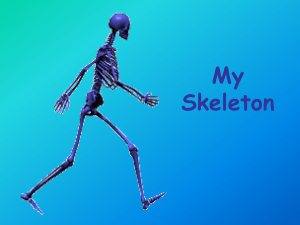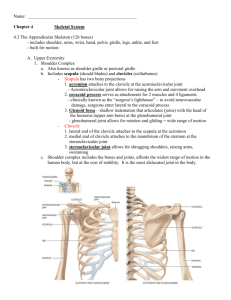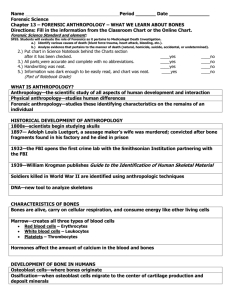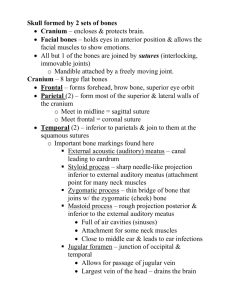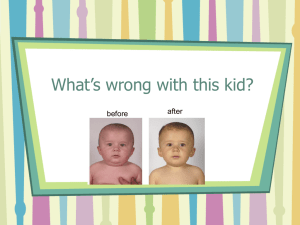Forensic Anthropology: Bone Analysis & Identification
advertisement
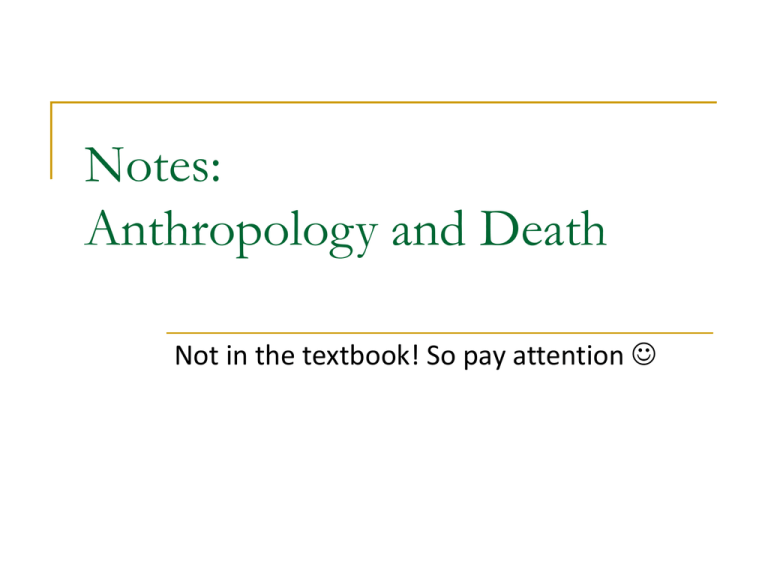
Notes: Anthropology and Death Not in the textbook! So pay attention Anthropology is the scientific study of human development and interaction. Tools, language, traditions, and social interactions Forensic Anthropology studies these identifying characteristics on the remains of an individual. First used to identify remains of WWII soldiers How Bones Connect Bones are held together by: a. cartilage—wraps the ends of bones and keeps them from scraping one another. b. ligaments—bands that connect two or more bones together. c. tendons—connect muscle to bone. Development of Bone Osteology--the study of bones Osteoblasts: Cells that form new bone Osteoclasts: Bone cells that break down and remove wastes from bones Ossification: mineral deposits that aid in the hardening of cartilage Osteoblasts Cartilage Ossification Throughout life, bones are being broken down, deposited, and replaced. What Bones Can Tell Us… Osteobiography tells us lots about a person through the study of the skeleton. The bones of a right-handed person, for example, would be slightly larger than the bones of the left arm. Record of the physical life. Questions can be Answered Using Forensic Anthropology Are the remains animal or human? Are the remains male or female? What is the age of the victim? Height of the victim? What was the manner of death? What was the cause of death? Animal or Human? Human and animal bones have very different structures When partial bones are only available, scientists look at the osteons Osteons are the holes in bones that carry blood In animals, they form regular patterns In humans, the patterns are known to be more random Male or Female? Females have a much wider pelvic bone than males for child-bearing purposes. Male or Female? (Don’t need to write) Region Bone Male Subpubic angle: 50-82 degrees Pelvic Sacral Female 90 degrees Shape of pubis Triangular pubis Rectangular pubis Shape of pelvic cavity: Heart-shaped Oval- shaped Longer, narrower, curved inward Shorter, broader, curved outward Sacrum: Male Female Front View of Skull Trait Shape of Eye: Mandible Shape From Underside: Upper Brow Ridge: Male Characteristics Female Characteristics More square More rounded More square More V-shaped Thick and larger Thin and smaller Male or Female? Male Female Side View of Skull: (Don’t need to write) Trait Male Characteristics Female Characteristics Occipital Protuberance: Frontal Bone: Present Absent Low and sloping Higher and more rounded Surface of Skull: Rough and bumpy Smooth Ramus of Mandible: Nuchal Crest: Straight Slanting Rough and bumpy Smooth Male or Female? Age? Growth plates called epiphyses form together and eventually unite with age. Age By about age 30, the lambdoid suture at the back of the skull will have closed. By about age 32, the sagittal suture running across the top of the skull, back to front, will have closed. By about age 50, the coronal suture running side to side over the top of the skull, near the front, will have closed. Height Just as age can be estimated by looking at the bones of the arm and leg, so also can an estimate of height be made. Often, the approximate height of a person can be calculated from one of the long bones even if just one of those is found. Gender and race will need to be taken into consideration in making the estimate. You can use the length of the femur to calculate an approximate range of height. Calculating Height Based on Femur Length: Male (2.32 x length of the femur in cm.) +65.53 ± 3.94 Female (2.47 x length of the femur in cm.) + 54.10 ± 3.72 Practice Problem: A partial skeleton of a female is found and the femur is measured and found to be 50cm. How tall was this woman? (2.47 x 50 cm) + 54.10 ± 3.72 177.6 + 3.72 = 181.32 cm 177.6- 3.72 = 173.85 cm If you had a conversion table: Converted to inches: 71.4 inches to 64.4 inches Divide by 12” This person would be a female that was 5’9” to 5’4” Racial Characteristics of Bone Caucasoid Negroid Mongoloid Shape of Eye Orbits Nasal Spine Rounded, somewhat square Rectangular Rounded, somewhat circular Prominent spine Very small spine Somewhat prominent spine Nasal Index <.48 >.53 .48-.53 Prognathism Straight Prognathic Variable Femur Fingers fit under Fingers will not fit Fingers will fit curvature of femur under curvature of under curvature of femur femur Race? Caucasoid: Descriptor for people of European, Middle Eastern, and East Indian Descent Race? Negroid: A descriptor for people of African, Aborigine, and Melanesian decent Race? Mongoloid: Descriptor for people of Asian, Native American, and Polynesian descent Facial Reconstruction Used when traditional methods of identification are not useful Uses standard tissue thickness and facial muscles to build a new face on a skull The skull and skeleton gives information about age, race, and gender Not totally accurate and is more of an art form based in science Facial Reconstruction DNA Evidence Bone contains little nuclear DNA but it does contain mitochondrial DNA. This has DNA that is inherited only from the mother. Long after nuclear DNA has been lost through tissue degeneration, mitochondrial DNA can be obtained from bone. Results can be compared with living relatives on the mother’s side of the family to identify skeletal remains.



